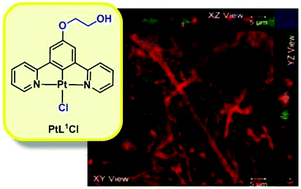Neutral N^C^N terdentate luminescent Pt(ii) complexes: their synthesis, photophysical properties, and bio-imaging applications†
Abstract
An emerging field regarding N^C^N terdentate Pt(II) complexes is their application as luminescent labels for bio-imaging. In fact, phosphorescent Pt complexes possess many advantages such as a wide emission color tunability, a better stability towards photo- and chemical degradation, a very large Stokes shift, and long-lived luminescent excited states with lifetimes typically two to three orders of magnitude longer than those of classic organic fluorophores. Here, we describe the synthesis and photophysical characterization of three new neutral N^C^N terdentate cyclometallated Pt complexes as long-lived bio-imaging probes. The novel molecular probes bear hydrophilic (oligo-)ethyleneglycol chains of various lengths to increase their water solubility and bio-compatibility and to impart amphiphilic nature to the molecules. The complexes are characterized by a high cell permeability and a low cytotoxicity, with an internalization kinetics that depends on both the length of the ethyleneglycol chain and the ancillary ligand.

- This article is part of the themed collection: Luminescent Complexes and Materials for Light-Emitting Devices

 Please wait while we load your content...
Please wait while we load your content...